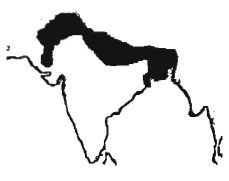Varanus Flavescens
 |
Yellow Monitor, Short-toed monitor-
The yellow monitor is a poorly known species and is considered to be one of the most endangered moni tor lizards. It is found only in Bangladesh, Nepal, india and Pakistan (Minton 1966; Smith 1932; Swan & Leviton 1962; Auffenberg et al 1989; Sarker 1987). Early reports of yellow monitor lizards in Burma were never substantiated and they probably do not occur there now (Smith 1930). This species bears a very strong resembl ance to Bosc's monitor, but its habitat and behaviour are very different. For a long time the yellow monitor was believed to be an inhabitant of dry areas but it is now clear that they frequent areas of marshes and swamps, usually along the floodpains or large rivers. These areas have been greatly modified by mankind for agricultural purposes, especially in the last century, and this has lead to the disappearance of this species from many areas that it previously inhabited, including Agra in western Uttar Pradesh, India (Smith 1932; Auffenberg et al 1989). Yellow monitors are sometimes found along streams in foothills but they appear to be unable to survive in mountainous areas. Although sand is the predominant substrate in most of the areas in which they occur, they appear to be intolerant of high salt concentrations and are therefore absent from coasts. Khan (1988) estimated densities of yellow monitors in suitable habitats within Bangladesh as being around 7.5 per km2
Yellow monitors reach a maximum length of about 100cm. The longest reported by Auffenberg et al(1989) was 92cm (4lcm SVL), the heaviest 1040g. Males do not grow appreciably larger than females. in Bangl adesh maximum length is usually 70-80cm TL (Sarker 1987). Hatchlings meuasure about 14.5cm (6.5cm SVL). Like Bosc's monitor the tail is comparatively short (120-130% of SVL). Sexual maturity is reached at around 25cm SVL. The colour of this monitor lizard shows great variation, even among animals in the same area, with many specimens showing red bands across the body. During the monsoon season the colours of both sexes become more intense. A description of the skull is given by Mertens (1959) and descriptions of the hemipenal morphology by Bohme (1988) and Khan ( 1993).
Many of the areas inhabited by the yellow monitor are subbject to extreme seasonal change. The animals appear to be most active during the wetter part of the year and least active in the dry wimer (November - February). They shelter in burrows, crevices in river banks or termite mounds (Khan 1998. Auffenberg et al 1989). They may seal their burrow entrances with a plug of earth (Auffenberg. pers. comm.). They have very short toes and are not efficient climbers. During the wet season, when their habitats are flooded, yellow monitors spend much of their time in water, building up large fat reserves to sustain them through the winter. Their diet consists largely of frogs, toads, turtle eggs and lizard eggs. They also eat frogspawn . mammals, birds and their eggs and a range of invertebrates, especially beetles and earthworms (Sarker 1987; Losos & Greene 1988; Auffenberg et al 1989). According to Auffenberg et al they do not eat molluscs. although these are available in many areas. However Sarker (1987) records predation on crabs. Mating occurs in June and July and an average of 16 eggs (maximum of 30) are laid from August to October (Whitaker & Khan1982; Auffenberg et al 1989). There is no evidence that they lay eggs in termite mounds. Theobald (1868 in Riley et al 1985) must be referring to the Bengal monitor when he claims that monitor lizards oviposit in termitaria in Burma. Eggs are probably deposited in burrows in elevated areas to avoid the possibility of nest flooding (Das, pers. comm.). In India hatchlings appear in March. Equal numbers of males and females have been reported, but males appear to be more active during the mating season.
In captivity the yellow monitor is a relatively inactive species. The only published account of breeding is that of Visser (1985). A pair housed in a 15m2 enclosure were active only for half all hour in the mornings and half an hour in the afternoon . Eggs incubated at 30°C hatched after 149-155 days. Unfortunately none of the youngsters survived. Like many monitor lizards. the yellow monitor likes to bask at very high temperatures (45°C). They should be provided with a soft substrate to dig in and enough water to submerge themselves for at least part of the year. In captivity in India three large frogs per week provide sufficient nutrition (Whitaker & Khan 1982), but vitamin and mineral supplements should be included in the diets of animals kept indoors. A varied diet consisting of invertebrates, amphibians and small mammals is probably most suitable. In captivity they can live for over ten years.
Despite the protected status of this lizard, trade in their skins during the 1980s was reported at almost half a million per year. most of which were exported to Japan. The lizards' period of greatest activity coincides with a seasonal drop in employment in agricultural areas, and as a result many people collect their skins and sell them on to dealers (Chakraborty & Chakraborty 1987; Luxmoore & Groombridge 1990). The yellow monitor has probably disappeared from most of its previous range and. with the exception of the Komodo dragon. is considered the most endangered of the monitor lizards.
Attribution / Courtesy: Daniel Bennett. 1995. A Little Book of Monitor Lizards. Viper Press U.K.




